Final
Performance Installations
Interaktionslabor Göttelborn
initiates new research venture at former coal mine in the Saarland
A Report
An international laboratory on interactive media convened at the former Coal
Mine Göttelborn in the Saarland, Germany, from July 1 to 14, 2003. On
the concluding weekend, the work of 20 artists and technologists was exhibited
during late night performance-installations in four different buildings in
the pit; during the day, guided tours through the laboratory were offered
to the public.
German-American choreographer Johannes Birringer had designed the interdisciplinary
fabric and philosophy of the Lab for the Industriekultur Saar (IKS), a regional
commission which oversees the infrastructural redevelopment of the Mine. The
Waag Society (Amsterdam) joined as a partner, and other regional high tech
firms provided equipment and technical assistance. Choreographers, musicians,
composers, architects, media and network artists from four different continents
arrived to set up shop in the Schwarz-Weisskaue, one of the largest and most
unusual buildings on site, formerly used as dressing-washing room (first and
second floor) and central office (third floor) of the Mining Company and the
5000 coal miners who worked here for many decades.
The Site:
Mining in the area of Göttelborn is documented since 1446, but the actual
systematic development of coal mining, the building of the technical facilities,
occurred during the height of the industrial revolution, circa 1887, under
the Prussian government. During that time the miners' dwellings, in the village
of Göttelborn, were also built. The whole area has the look of countryside,
with luscious trees, pastures, interspersed with the mining area and slack
heaps, and a new power plant built there in the 60s, its smoking chimney widely
visible. In 1995 the Mine added the new white tower (shaft IV), with its colossal
pyramidal framework considered the tallest mining tower in Europe. Paradoxically,
the mine closed a few years later when coal was no longer considered profitable.
In 1995, there were still about 4200 workers on location. IKS director Karl
Kleineberg administers the "future" of the site and the research
into the sustainability of regional industrial culture; he sees the vacant
site as a 'town' with an urban topography.
The Laboratory
The Laboratory was designed to help initiate the re-utilization and conversion
of the abandoned site which now anticipates economic and architectural development.
The role of new media/technology is considered vital in this changing landscape
of industrial culture. The Lab sees itself as an innovative platform for integrated
research projects in media arts and technologies, with a special focus on
interactive interfaces and telecommunications.
On the one hand, the Lab team knew that it had gathered under non-familiar
circumstances, on a site filled with heavy machinery and still guarded by
the Mining Company which is responsible for security and the decontamination
and dismantling of the engines and extraction equipment. The team used the
first days to familiarize itself with the environment, the Mine’s engineering
history, and its own task of setting up laboratory conditions under which
it could establish Göttelborn as a test-site for several networked performance,
sound recording, and film projects, and as a "shop" for building
interactive wireless sensor applications to be presented to the public during
the visitors’ days.
On the other hand, the simultaneous presence of the Schichtwechsel Festival,
a regional organization which had programmed a theatre touring production
to take place at the Mine, raised interesting questions about the role of
artists using the industrial ambience as backdrop for spectacle-entertainment.
The Lab defined its role mainly as research-oriented, while also seeking to
establish connections with the community to find out how software and media
applications could be used to motivate and inspire new ideas for creative
infrastructure-development.
The work phases:
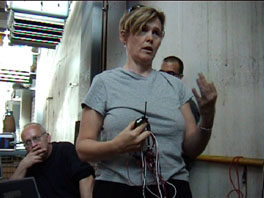 Lynn,
Paul and Mark
Lynn,
Paul and Mark
1. Workshops
During the first 10 days, the group held daily workshops during which members
shared their diverse practices, methodologies and current project-ideas for
collaboration. Jim Ruxton and Jeff Mann, for example, offered workshops on
sensor technology and micropocessors. Arri Keesmaat demonstrated the Keyworx
real-time multiuser platform after installing a local server. Kelli Dipple
introduced her work in network technologies and telepresence performance,
and Paulo C. Chagas suggested creating an interactive soundwork based on texts
and recorded voices from the group. Orm Finnendahl demonstrated the PD patch
on his Linux system which he had prepared for real-time processing of recorded
sound on the site. Alan Smith showed films from his previous work in the lead
mines in Northumberland and emphasized the need for poetic encounters with
historical residue.
2. Site Work
On any given day, members went on excursions into the mine to gather materials,
record sounds and shoot film, to extract information and to examine the architecture
and topography of the mine as a resource and inspiration for new ideas. Alan
Smith and Kelli Dipple shot and edited several short films on location, and
both Marija Stamenkovic and Koala Yip created dance performances that were
filmed on the roof of one of massive concrete buildings (the sinking pond).
Webcams were set up, and a digital archive and website developed and updated
every day (http://www.iks-saar.net). Affiliations were made with several cultural
locations in the region, including the Stadtgalerie, the children's museum
(Saarlandmuseum), and the K4 Forum in Saarbrücken, the regional capital.
Klaus Friedrich, a graphic artist from the region who joined the lab, volunteered
to create an "outpost" in the K4 Forum, installing videos and photographic
collages from the lab process as well as setting up a network connection.
The Lab also communicated with the Schichtwechsel Festival, the non-profit
organization which produces theatre, dance and music concerts in former industrial
plants.
3. Team-work and Programming
The creative energy of the Lab resided to a large degree in the fortuitous
combination of transdisciplinary knowledge and expertise brought together
for the common good by participants who came from very different backgrounds
and brought their artistic techniques, cultural and linguistic sensibilities,
and many suitcases full of tools. Very soon smaller teams found themselves
and worked together on specific investigations;
there was space for individual ideas and pursuits but the full group always
adhered to a common ethos of collaboration. During the daily meetings it was
decided to develop three or four interactive media scenarios on the basis
of architectural sketches, design plans and programming carried out on site.
Convergences between the various interface scenarios were examined, and locations
sought out for the public installation of these
scenarios.
4. Outreach
The Lab did not seek to operate in isolation or as a private enterprise nor
rely on the media and press to broadcast its presence. As a new venture it
lacked staff support, organizational and other logistical infrastructure (there
were no phones, and no water or electricity in some of the buildings), but
it tried to define a public function for its operation, and to communicate
its open-source work to the community. We had cell phones and network access.
Camille Turner led the effort to establish connections to the local population,
to invite citizens to visit, and to start a dialogue. She used the performance
of a character ("Miss Canadiana") as a tactic to participate in
a local village festival, bringing gifts to the children and inviting the
villagers to be photographed and interviewed with the fictitious beauty queen.
The interviews focussed on the local people’s ideas and hopes for the
future of their community. The large contingent of Canadians in the Lab team
was due to the fact that Birringer had presented a short preview feature on
the Mine project at Subtle Technologies (Toronto), the unique arts and science
conference organized annually by Jim Ruxton. The Interaktionslabor followed
the integrative principle of Subtle Technologies but provided a small transdisciplinary
factory for interactive tools in art and everyday life.
The guided tours on the final weekend were held to demonstrate to the visitors
how the lab team had tested new media applications (data archives, wireless
sensors, mobile computers, telepresence, interactive real-time processing
systems involving sensors and motion tracking, etc) and the relations between
new media and everyday life. The team asked itself how such applications can
be made accessible to users in sensual and attractive ways, and how interactive
media can become exciting, creative learning tools in education. A class of
14-year-olds from a high school nearby was invited to visit the lab and get
a first-hand look at the tools.
 8m2
visiting the lab
8m2
visiting the lab
The ResultsThe Interaktionslabor proceeded to explore three areas of research:
communication technologies, interactive media, virtual environments. The urban
architecture of the Mine became the material source for interactions defining
Göttelborn as a transitory space: the location was treated – with
regard to sustainability research - neither as something to be preserved (museum
of industrial culture), nor as a theatrical setting for festival entertainment,
but rather as an open place of transformation processes.
A laboratory mediates knowledge processes that can be used in other areas
of training. This transferability is particularly meaningful in view of new
communications strategies that involve internet, video and cellular conferencing
technologies and wearable computing. They have an impact on new concepts of
urbanity, life styles and mobility, and they offer a perspective for the younger
generations growing up in the region.. A study of networked environments takes
up questions implicitly raised by the IKS and its search for investments into
new infrastructures.
In a basic sense, the lab provided a workshop for skilled labor and artisanship,
it converted existing spaces, generated stories, images, sound(radio broadcast),
hardware and software design and network solutions. The team moved around
a lot, dancing, making music, scavenging, constructing. Canadian artist Jeff
Mann, for example, constructed a special antenna that enabled wireless access
from the top of the Tower, Shaft IV. From that towering vantage point he was
able to send a video stream to Sher Doruff (Waag Society, Amsterdam) who created
a Keyworx configuration that displayed the images from Jeff's camera mixed
with an audio visualization of their conversation on walkie-talkies. Queries
from the audience, communicated via text messaging from Blackberry PDA's set-up
by Renn Scott and chalk drawings made by visitors on the pavement were further
displayed in the image mix in the Winding Engine Building.
The Interaktionslabor thus challenges the restructuring plans of the IKS.
Investment or the creation of new jobs can not only mean the importation of
artistic product into the abandoned industrial facility or the leasing of
real estate. Interactivity means setting in motion, programming a sensitive
interface and an active space that requires agency to generate new realities.
Interactive media art here implies above all performative processes that involve
communicative action with different resonances in public and social environments,
in the sense of that interaction is social process requiring feedback, and
design is the invention of new cultural interfaces.
Interaktionslabor, Inc.,could function as a company. It could develop the
already emerging partnerships within the team (between the WAAG Society for
Old and New Media, Amsterdam, REM in Toronto, the blueLab in Dresden, Nottingham
Trent University’s Live Art program, etc) as well as with partners found
in the region and the Göttelborn community. Such a network creates practical
alliances between art, science, technology and the life world, not satisfied
with the short-term magic of theatre in abandoned factories, but dedicated
to long term research in active media applications.
The Performance
How are we to view the late night performance, then? It might be best to call
it a "virtual environment," a hybrid installation displaying the
potential of creative media design through demonstrations and performances,
through play and chat, through participation. The demonstration would not
have been possible without the chemistry that existed between the artists
who had come here from many different backgrounds and countries (Germany,
the Netherlands, Austria, England, Spain, Canada, the US, Latin America and
China). What connected everyone was a shared interest in creativity and critical
thinking, interface development and tinkering, and a passion for discovering
resonant dimensions in the social interface arising from real-time virtual
environments that connect bodies and sensory technologies.
Finally: some examples from the late night performance which aroused the positive
reactions of the public: some audience members returned the next day to take
a closer look at the interface design and express their interest in the continuance
of the Lab.
Architect-performer Marion Tränkle had reshaped the 10 "cells"
of the Schwarzkaue (the 70 meter long south dressing room) into different
"apartments", available for different purposes and to be used by
the audience in their encounter with cameras, sensors, monitors and objects
(found or newly constructed). Most of these objects invited the audience to
rely on trusted perceptional mechanisms, involving various aspects of story-telling,
photographs and videos functioning as an archive of the physical interfaces
between lab team and local population. Tränkle had also designed a "discussion
table", with interactive apples, which solicited questions, when touched,
about the future of Göttelborn, and Julia Baur had built a memory game-table
out of her photographs from the site, hinting at the imaginative and playful
use (for leisure time activities, inline skating, etc) of the large open areas
on the south side of the pit.
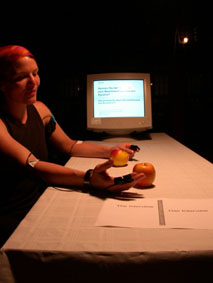
Marion's "discussion table"
Jim Ruxton had helped Tränkle and others to construct the different sensors
and microprocessors which were used in the building, including those for the
"glowing soap" in the dark washrooms, which "spoke" to
the visitors if someone stepped through the ultrasonic beam. In this building
we used all the sensing devices commonly used for interactive design: haptic
sensors (pressure, touch, flex, and proximity), non-haptic sensors (distance
sensors such as ultrasound), and microphones. In the Weisskaue (the north
dressing room), composer Orm Finnendahl used the entire space as a gigantic
"sound production room", suggesting to the visitors that they could
generate the sounds (recorded via microphones) themselves which were then
processed by the computer in real-time and spatially distributed via an 8-channel
speaker system. Two dancers, Koala Yip and Marlon Barrios Solano, then performed
a movement improvisation with sensors that demonstrated how sound textures
could be dynamically developed in new and surprising manifestations.
During discussions with the audience, Yip referred to the physical interactive
experience and how movement feels in such a resonant and responsive space
when each gesture can instantly alter the tonalities of sound and make moving
clusters of music (in the psychoacoustic perception of space) seemingly appear
in different parts of the building. She also pointed out that she did not
rely on a choreography but explored the nature of such processual interactivity,
which is its instability, emergence, and mutability in the present moment.
Interactive dance, in this sense, is never merely a stimulus-and-response
behavior, but a psychophysical and emotional experience which engages the
entire body sensing system in motion, and in continuity, which creates layers
upon layers of affect that of course cannot be measured by the sensors. For
the audience, the intensity of these affects is experienceable as sensation,
there is a synaesthetic and energetic exchange, and the emotional intensity
of Koala’s and Marlon’s dance was of course heightened by the extraordinary
setting, the thousands and thousands of steel baskets that hung empty and
suspended in the air of the Kaue. The coal miners had used these baskets to
store their clothes before going down to the shafts.
At the end of the south corridor, a small, intimate bathroom that had been used by the mining engineers was transformed into a silent installation by Marija Stamenkovic Herranz. Reflected on two sides by mirrors, a small video monitor sat on a rusty chair and showed the ghost-like appearance and disappearance of a woman walking a circular path around the "eye" or vortex of the sinking pond the lowest point of the circular building where the water used for cleaning the coal dropped down into a pipeline. Marija¹s video, "Do U C Me You," was a quiet but disorienting poem; shot with a webcam in grainy black and white, it had the look of overexposed film. The figure-ground relationship changed constantly insofar as we could never be sure how many Marijas we would see: doppelgänger images appeared suddenly and then faded away as the women in black silently enacted their ritual perambulations, like monks in some long-forgotten cloister.
A similar transformation, here in the sense of an ebbing and flowing momentum,
was heard in the "Verlesesaal" (the reading room where miners received
their daily task sheets). Brazilian composer Paulo C. Chagas had installed
a layered composition of voices (4 channels) designed to change interactively
when the audience would step into a specific area. Simultaneously, this portion
of the ground came alive with projected text in an interactive design by Arjen
Keesmaat. Words appeared on the surface, as if from nowhere (projected from
above), and then faded away, and these words only became visible and grew
larger depending on the velocity of movement by an audience member stepping
into the purview of the infrared camera. This room displayed, in its quiet
and even magical way (lit only in blue light) a kind of lunar cycle, a whispering
night, mental maps and superpositions of possible communicative meanings,
women’s voices in several languages telling stories.
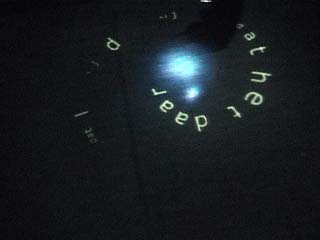
Before Chagas started the loopular program, a ritual poem performed by Camille
Turner and addressed to Santa Barbara (patron saint of the Mine, Yoruba deity)
in memory of her parents introduced a spiritual dimension which was altogether
unexpected, by the lab team as well as the audience. Camille took everyone
by surprise, except her special guests, a local men’s choir she had befriended
and invited to join her that night. The choir, steeped in local and European
song tradition, responded to her poem by offering several songs in German,
Russian, and Ukrainian, and interaction here gained cultural and social meanings
that point beyond the technological interface design, perhaps to the sense
of "transduction" as a collective process. As a "communication
design", the song and the ritual repetition of Camille’s rhythmic
intonation of her poem functioned clearly as a collective cultural infrastructure,
like a prayer for survival, a reminder of our mortality. The song also reminded
us that even the newest electronica and digital sound are only an instrument
like other cultural technologies.
The Verlesesaal became the poetic core of the evening, with saxophonist Hartmut
Dorschner entering the space later on to play his acoustic instrument, after
he had processed some digital samples of the sound of a creaking door earlier
on, while Alan Smith projected a sequence of six short films he had composed
of his personal interactions with the landscape and the found signage of the
Mine (e.g. "Safety begins in the Head"; "Order is Safety",
"Eve loves Professionals", etc). His films were full of poignancy
and humor.
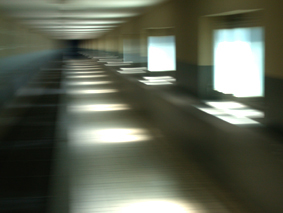
Near midnight the audience was guided further north along a quiet avenue to
the winding engine building for the Tower (Shaft IV) where the final performance-installations
took place. Renn Scott, who works as user experience architect for REM (Research
in Motion) Company in Toronto, had brought several new Blackberrys (cellular
computer telephones) to hand out to the audience, and the walk to the engine
room turned into a navigational game and audience intercourse with the "Control
Tower," where Jeff Mann sent SMS instructions to the users, inviting
them to send messages back and carry out some activities at a particular location
where the camera on the tower could capture them. The camera pics were then
sent (via Apple airport) to the laptops, and by the time the audience entered
the engine room the pictures from the game of the participants were ready
to be processed...
The gigantic dark engine room received the public with an experimental arrangement
that almost literally took their breath away, and I mean this in a visceral
and vicarious sense. Upon entering a door leading to a staircase, the audience
would glance down 30 or 40 feet to an empty space where one of the two winding
engines of 10000 horsepower had stood, the remaining one now facing our "opera"
auditorium, a deep resonance body, with the western wall serving as film screen.
The collaborations between Lynn Lukkas/Mark Henrickson (Minneapolis)/Paul
Smith(Bristol)/Marija Stamenkovic (Barcelona), Kelli Dipple (Australia) and
Yip/Birringer/Barrios Solano pointed to other possibilities of the sensation-technology,
emphasizing the interactivity between visual media and performance, corporeality,
amplified sound and resonant space.
In the first interface environment, programmed by Lukkas, Smith, and Henrickson,
the body’s actions are measured not only as sound (via microphone), but
rather as the most subtle variations in the biomechanics: the pulse, breath,
and heart rhythm in the body itself (by means of a Bioradio attached with
electrodes). The electrically measurable signals are transmitted wirelessly
as data to the computer. There they change not only the sound processes in
real time, but affect the rhythm of the image movement of the projected film
sequences stored in the computer (via Macromedia Director and Max/Msp). Marija
Stamenkovic Herranz performed this dance of breath, first improvising softly
with extended vocal techniques as she descended the staircase in midst of
the audience, then purely with heavily amplified breathing as she moved onto
the flat plain of the engine room, and finally with her whole body and staccato
voice as she propelled herself into a wild trance-like flurry of movement.
Her voice crept under our skins, the resonating sound in the huge room entering
through our pores and stomachs, and as we listened we realized how her breath
controlled the image movement and thus the dramaturgy of the story.
If Marija stops her breath, the film’s motion freezes. When she breathes,
we see her (on film) walk across the slack heap of the Mine, descending into
a hollow path. Lynn had also filmed her movement outside differently in each
section, the third one using a hyperactive zoom. In conjunction with Marija’s
accelerated breathing, this final segment materialized as pure hyperkinetic
sensation, transforming the entire space into a irregular
pulsating bodymachine of continuously unfolding exhaustive (libidinal?) intensities.

A performance of this kind is hard to describe, but the spectrum of the evening
demonstrated the variety of interactive interfaces (sound, image projection,
body, voice, writing, acoustic space, wireless communication, etc) at the
threshold between pure sensation and theatrical expression, where a performance
dramaturgy and a poetics become anticipatable if one were to develop and structure
a full work for presentation rather than an interactive installation for the
audience-user. In the case of Marija’s performance, her interaction of
course was also with her own image (on film), and thus with a remembered movement-trajectory
she had enacted outside.
Kelli Dipple, on the other hand, showed a short interactive improvisation
(on the theme of "absence") with a triptych of Quicktime movies
she had shot of herself in the Mine, and then invited the audience to join
her and do the same, leaving something of themselves (as trace) in the space.
In her films, she focused on the Mine as a space of disappearing bodies, and
her treatment of the interface itself seemed to comment on the disappearing
effect of programming that allows for randomness and certain kinds of recognition,
not others. Her interface was set up with a video camera as input device for
the interactive system (BigEye): it could see space and track motion and color.
Her parameter defined dark colors as a "present body," and the dynamics
of the movement decided which film of her disappearances we would see (and
in which direction, forward or backward). Kelli’s "game," which
simultaneously involves spoken passages activated by certain gestures or movements,
implicates the audience and thus potentially motivates and integrates its
movement and the interpretation of the collective moment (someone is being
disappeared from our midst). Perhaps it is possible to argue that such an
interactive design animates the audience user to negotiate a game of relationship
to the image, and to take responsibility.
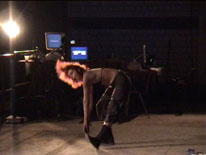
Like Kelli, Birringer had also filmed in the Mine and created a 6-minute movement
study of a dance by Koala Yip on the roof of the colossal sinking pond rotunda.
Entitled "Oracle," the film was not shown in its edited form. Rather,
Johannes asked Koala to question the Göttelborn oracle again in her native
language. Her voice (via wireless microphone) then animated sections of the
film in real time, processed in a Max/Msp/Jitter patch programmed by Marlon
Barrios Solano. The algorithmic process translates Koala’s voice into
new digital objects -- distorted, pulsating, curved, exploding and shrinking
picture-animations that bear little relation to the original dancefilm, even
though one can still recognize Koala standing above her mirror reflection
in the dark watery vortex of the sinking pond. The film became a virtual film;
no predictions of the future were provided except the echoes of Koala’s
vocal intonations pulling, stretching, and scratching the digital emulsion
of the filmstrip.
The Interaktionslabor of course pointed its finger at the future and asked
what kind of influence virtual environments might have on our imagination,
and what intuitive associations people make with such technically mediated
interactions. How can architectures of virtual image-sound-spaces emerge to
form meaningful sensual experiences for social interaction, allowing us to
recognize our bodily activity? How is the virtual felt? What relationships
are forged between portable/mobile media and the persons who use them? How
do relations between body and media develop into symbolic actions or interactive
games which we understand as meaningful collective cultural behavior? What
balances can we achieve between nature, industry, digital culture? Digital
nature?
With these questions in mind, the laboratory plans to continue its work and
regroup next year, while strengthening the partnership with the IKS that has
been initiated now. In order to develop continuity for the research in Göttelborn,
Birringer and project coordinator Uschi Schmidt-Lenhard (Saarbrücken)
have devised a long-term R&D plan that examines further convergences between
media technologies and art education, learning systems and cognitive processes,
design and ecology, science, sustainability studies and everyday life. The
Interaktionslabor, Inc. will be available as a dialogue partner for firms
and cultural organizations in the region; it will also serve as a network
partner to interested parties elsewhere.
(c) Johannes Birringer